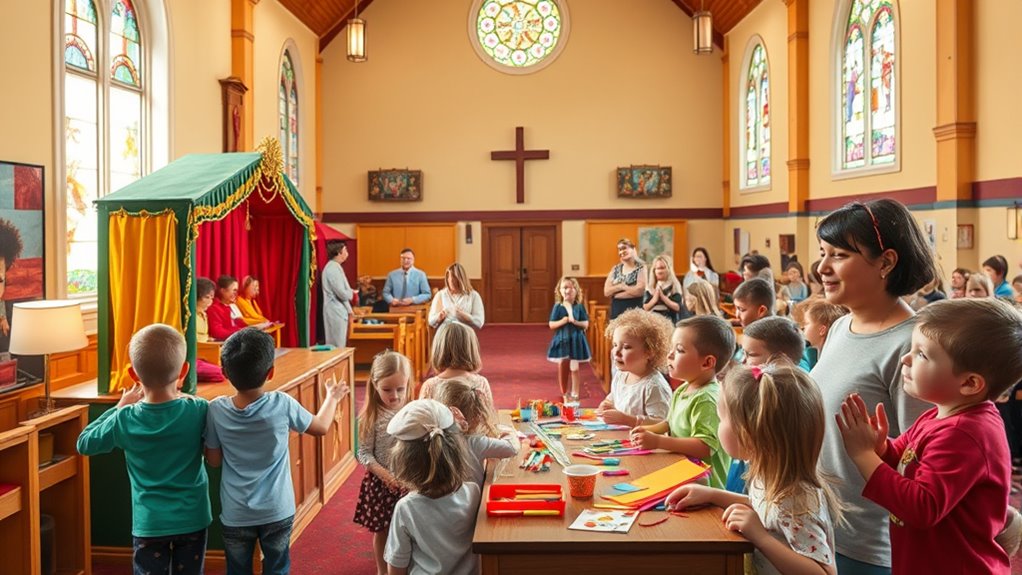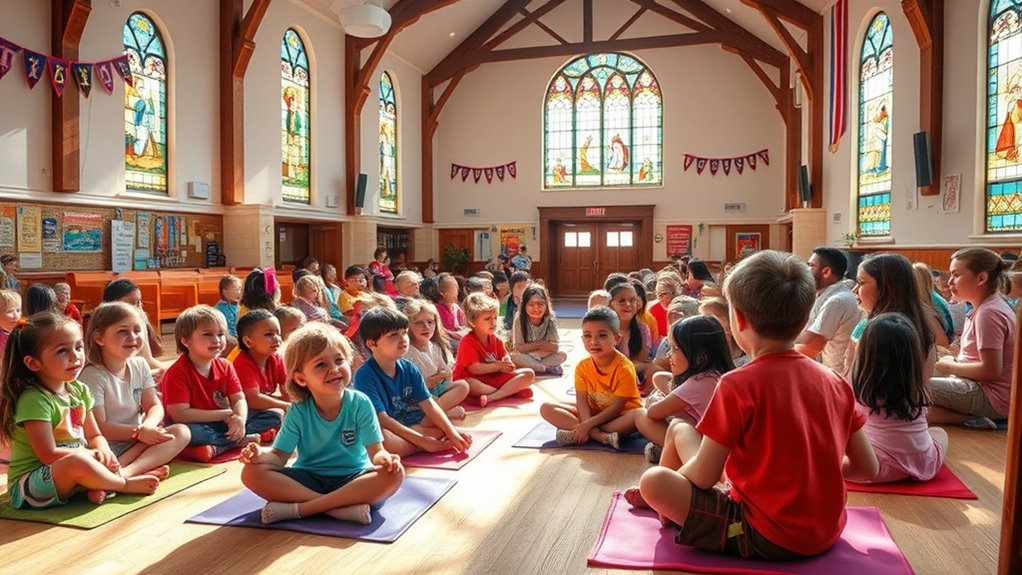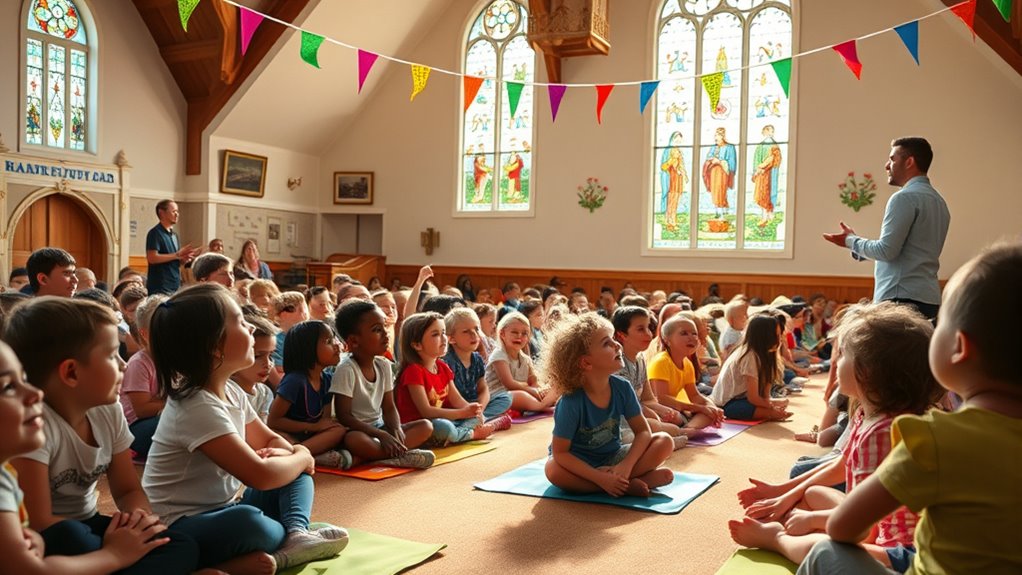To make church exciting for kids, create a welcoming environment with bright colors, friendly murals, and comfy furniture that invite participation. Incorporate hands-on activities, such as crafts or group games, and make use of lively music and movement to keep their energy engaged. Use visuals, stories, and technology like projectors to make lessons come alive. If you keep exploring, you’ll discover even more ways to make worship meaningful and fun for children.
Key Takeaways
- Incorporate colorful, child-friendly decor and interactive sensory activities to create a welcoming, engaging environment.
- Use lively music, movement, and visual storytelling to capture kids’ attention and make worship fun.
- Design age-appropriate lessons with creative crafts, group games, and hands-on projects to deepen understanding and participation.
- Empower children with leadership roles like leading songs or sharing insights to foster ownership and excitement.
- Maintain a supportive, consistent church atmosphere that balances fun and spiritual growth, encouraging ongoing engagement.
Creating an Inviting Atmosphere for Kids

Creating an inviting atmosphere for kids begins with making your church space warm and welcoming. Use child-friendly decor, such as bright colors, playful murals, and comfortable seating, to create an environment that feels safe and engaging. Adding elements like soft rugs, friendly wall decals, and accessible furniture helps children feel at ease from the moment they enter. Keep decorations simple, colorful, and age-appropriate to foster curiosity and excitement. A welcoming environment encourages kids to participate freely and builds their connection to the church community. When your space feels inviting, children are more likely to focus, learn, and enjoy their time, laying a foundation for meaningful spiritual growth and a positive church experience. Incorporating child-friendly decor that aligns with the overall atmosphere can significantly enhance their comfort and enthusiasm.
Incorporating Interactive Worship Activities

Incorporating interactive worship activities keeps kids engaged and excited during services. You can include creative hands-on projects that allow them to express their faith practically. Additionally, dynamic group games can make worship fun and memorable for everyone involved. Incorporating unique and wicked planters can also serve as a visual and interactive element to teach children about growth and nurturing in their faith journey.
Creative Hands-On Projects
Adding hands-on projects to worship activities keeps kids engaged and helps them connect with spiritual lessons more deeply. Creative arts and craft stations allow children to express their faith creatively while reinforcing key messages. You can set up stations where kids create prayer journals, make biblical character puppets, or craft symbols of faith like crosses or doves. These projects encourage active participation and make worship memorable. Consider incorporating:
- Drawing or painting biblical scenes
- Making prayer bracelets or necklaces
- Creating faith-themed collage art
- Designing personalized prayer boxes
These activities turn learning into an interactive experience, making worship fun and meaningful. Kids retain lessons better when they can touch, see, and create, fostering a deeper spiritual connection. Additionally, integrating payment processing concepts such as secure online transactions can facilitate digital donation options for churches, making it easier for families to contribute to church activities.
Dynamic Group Games
Engaging kids through hands-on projects sets a lively foundation for worship, but keeping their energy focused during the service is just as important. Dynamic group games help achieve this by encouraging teamwork through fun team building exercises. These activities foster a sense of community and cooperation, making worship more interactive. Incorporate storytelling techniques into games to deepen understanding of biblical lessons while keeping kids engaged. For example, you might play a game where children act out a Bible story, helping them internalize the message actively. These activities not only energize children but also reinforce spiritual concepts in a memorable way. When you combine team building with storytelling, you create a vibrant, engaging environment that helps kids connect with their faith and each other. Additionally, incorporating interactive storytelling techniques can significantly enhance their engagement and retention of spiritual lessons.
Using Music and Movement to Engage Young Minds

Music and movement are powerful tools to capture kids’ attention and make learning about faith fun. When you incorporate rhythm and melody, you create an engaging environment that keeps children involved. Use dance and movement to help kids physically connect with the message. To do this effectively, consider these ideas:
- Incorporate simple, catchy songs with clear rhythm patterns
- Encourage children to dance or sway along with the music
- Use hand motions or body movements that match the lyrics
- Create opportunities for children to improvise movements, fostering creativity
- Including anime movies with vibrant visuals and compelling stories can also enhance engagement and make learning more enjoyable.
Incorporating Visuals and Technology in Worship

Incorporating visuals and technology into worship can transform the experience for kids, making it more engaging and memorable. Augmented reality brings biblical stories to life, allowing children to see and interact with scenes in 3D right from their seats. Digital storytelling captures their attention with vibrant visuals and sound, making lessons more relatable and easier to recall. Using projectors and screens, you can display animated videos or colorful illustrations that reinforce key messages. These tools help kids connect visually with the worship content, deepening their understanding and involvement. Additionally, incorporating best beaches and scenic views related to biblical stories can create a more immersive environment that appeals to their natural curiosity, encouraging active participation and enhancing their overall worship experience.
Planning Age-Appropriate Lessons and Messages

To effectively connect with kids during worship, you need to plan lessons and messages that are appropriate for their age and developmental level. This guarantees they stay engaged and grasp the spiritual truths. Focus on message development that resonates with their understanding, using simple language and relatable stories. Consider these key points:
- Tailor content to match different age groups for maximum engagement
- Use visuals and stories to make complex ideas accessible
- Incorporate questions that encourage reflection without overwhelming
- Adjust activities to suit attention spans and energy levels
- Employ self-watering plant pots as a metaphor to demonstrate how consistent care helps growth, illustrating spiritual nurturing in a tangible way.
Encouraging Active Participation and Leadership

You can make church more engaging by empowering kids to take on leadership roles and share their ideas. Incorporate interactive activities that encourage them to participate actively and build confidence. When kids lead, they feel more connected and excited about their faith community.
Empower Kids to Lead
Empowering kids to lead transforms their church experience from passive attendance into active participation. When you involve children in leadership roles, they gain confidence and a sense of belonging. Parental involvement plays a crucial role, as it encourages kids to see leadership as a natural part of their faith journey. Spiritual mentorship provides guidance, helping them develop skills and understand their responsibilities. You can:
- Assign them small leadership tasks during services
- Encourage them to share their thoughts in prayer or group discussions
- Support their ideas for church activities
- Celebrate their contributions publicly
- Recognize the importance of trustworthiness and safety measures to ensure a secure environment for young leaders
This approach fosters a sense of ownership and motivates kids to engage deeply. By giving them opportunities to lead, you help them grow spiritually and feel valued within the church community.
Incorporate Interactive Activities
Incorporating interactive activities into your church programs invites kids to participate actively and take on leadership roles naturally. Use storytelling techniques that involve sensory exploration to make lessons memorable and engaging. Activities like role-playing, hands-on crafts, or movement games help children connect with the message and stay involved. These techniques foster active participation and confidence, encouraging kids to lead parts of the service or Bible stories. To emphasize the importance of engagement, consider this:
| Active Role | Sensory Exploration | Leadership Opportunity |
|---|---|---|
| Storytelling | Touch, sound, sight | Leading a prayer or song |
| Crafts | Textures, colors | Organizing activities |
| Movement | Actions, rhythm | Hosting group games |
| Discussion | Dialogue, questions | Sharing insights |
Additionally, understanding and balancing work-life commitments can help ensure a supportive environment that encourages children’s spiritual growth and active participation.
Frequently Asked Questions
How Can I Address Differing Developmental Needs Among Children During Worship?
You can address differing developmental needs by incorporating music therapy and story-based learning into worship. Use engaging songs and musical activities suited for various ages, helping children connect emotionally. Incorporate storytelling that captures their imagination and suits their understanding levels. By blending these approaches, you create an inclusive environment where all children feel involved and nurtured, fostering spiritual growth and making worship meaningful for every age group.
What Strategies Ensure Consistent Engagement From Children With Special Needs?
You can guarantee consistent engagement from children with special needs by providing sensory accommodations like quiet spaces or noise-canceling headphones, which naturally align with their needs. Incorporate an inclusive curriculum that highlights diverse abilities and learning styles, making worship accessible and meaningful. By intentionally blending sensory accommodations with an inclusive approach, you create a welcoming environment where every child feels valued and engaged, fostering deeper participation in worship.
How Do I Handle Behavioral Challenges During Interactive Worship Activities?
When behavioral challenges arise during interactive worship, you should calmly address the situation by setting clear boundaries and using positive reinforcement for good behavior. Redirect attention gently and praise children who follow instructions, reinforcing positive actions. Consistency is key—stay calm, firm, and supportive. This approach helps children understand expectations while feeling encouraged, making worship time more engaging and enjoyable for everyone involved.
What Resources Are Best for Training Volunteers to Work With Kids Effectively?
Imagine you’re preparing volunteers for a vibrant kids’ worship program. The best resources include all-encompassing volunteer training programs that cover child development principles and effective engagement strategies. For example, a church might use online courses or workshops focused on age-appropriate activities and behavior management. These resources help volunteers understand kids’ needs, build confidence, and create a nurturing environment, ensuring they work effectively with children during worship.
How Can Parents Be Encouraged to Reinforce Worship Engagement at Home?
You can encourage parents to reinforce worship engagement at home by suggesting they incorporate faith into daily routines, making spiritual discussions natural and ongoing. Encourage parent-child bonding through shared prayer, Bible reading, or singing worship songs together. Offer simple resources like devotionals or activity sheets, and remind parents that consistent, loving involvement helps children see worship as a meaningful part of their everyday lives, strengthening their spiritual growth and family connection.
Conclusion
By embracing these ideas, you create a warm, lively environment where children feel inspired and enthusiastic to connect with faith. When you make worship welcoming and fun, you gently guide young hearts to discover their own special place in the church family. Remember, fostering joy and curiosity helps them grow spiritually, like a delicate flower blooming in the sunshine. Keep nurturing their spirits, and watch your congregation blossom with renewed energy and hope.










